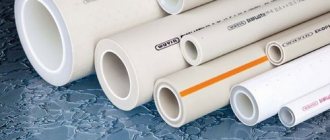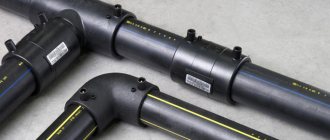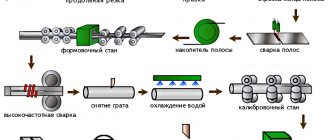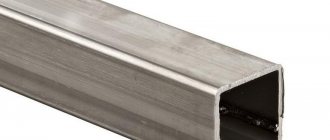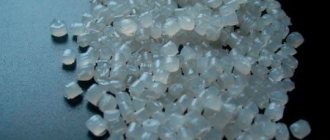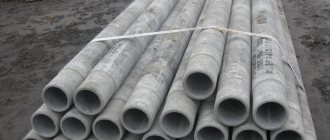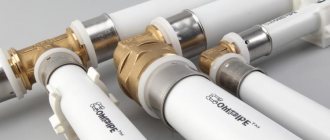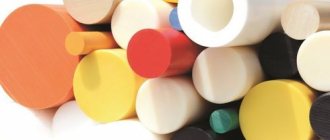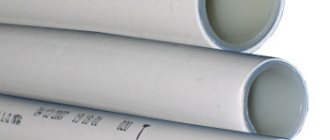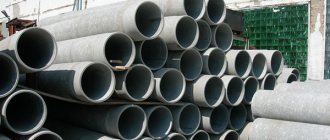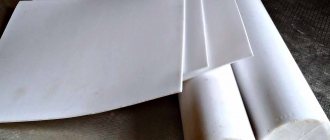Pipes made of high-density polyethylene are a fairly soft, but at the same time extremely elastic material. It is worth paying attention to their chemical structure: the molecules create a very strong crystal lattice with branches of various lengths, the bonds between the molecules are weak, but it is precisely because of this that the material has such a high level of elasticity, compressive and tensile strength, and resistance to mechanical damage.
High-density polyethylene is a three-layer material reinforced with synthetic thread. Most often, pipes made from it are used in structures for supplying industrial and drinking water, as well as other liquid media supplied under pressure not exceeding 3 MPa. These pipes can be buried in the ground without special protection, or laid in walls and other closed structures.
What are high pressure polyethylene pipes?
The main component in LDPE products is polyethylene. It is produced using extrusion technology, which makes products made from it environmentally friendly. Now on the construction market you can find pipes with different diameters, but the most popular are products with an internal section width of 16, 20, 25 and 32 millimeters. LDPE pipes are produced in convenient coils, coils or in the form of straight sections.
There are LDPE pipes with much larger diameters from 180 millimeters, which are produced exclusively in long straight sections from 5 to 24 meters long. This form is very convenient when installing a water supply system in summer cottages, when it is possible to purchase a small pipe of the required length for arranging a summer shower and similar equipment. Now in Russia all polyethylene pipes are produced according to state standard 18599-2011.
In addition to water supply systems, LDPE pipes are often used as a protective case for power lines, which is an indicator of the reliability and strength of this material. High-density polyethylene is resistant to mechanical damage even when installed in walls.
However, most often polyethylene products are used to supply liquid over various distances. The main advantage of this material is that drinking water does not lose its quality during transportation, the internal surface of the water supply system is not covered with deposits, the outer part does not allow any foreign impurities or chemical compounds into the system and does not itself release them into the transported substance.
Advantages of PVDF pipes
The advantages of PVDF pipes are as follows:
- high chemical resistance to aggressive environments;
- wide operating temperature range of -40..+140 degrees;
- high thermal stability;
- resistance to abrasive wear;
- absence of microimpurities;
- lack of cold flow and aging in the sun;
- low weight and ease of installation;
- excellent resistance to various microorganisms;
- no need for pipeline maintenance;
- UV resistance.
Pipes made of PVD and PVDF, despite significant differences in both design components and areas of use, are quite widespread and widely used due to their excellent technical characteristics and relatively high cost.
Did you like the article? Subscribe to our Yandex.Zen channel
Advantages and disadvantages of the material
Pipes made of high-density polyethylene compare favorably with other polymer products with a number of advantages. The main advantage of this material is its complete resistance to corrosion and chemicals, which was the main reason for its popularity. At the same time, LDPE pipes have other advantages:
- Low level of thermal conductivity, which significantly reduces heat loss during liquid transportation. In addition, this reduces the amount of condensation that forms on the internal walls of the system. Water is supplied to the consumer without changing the required temperature.
- In that situation, if the liquid is frozen inside the structure, the pipes do not deform. This was made possible thanks to unsurpassed elasticity and flexibility. The material expands when ice forms, and after defrosting it returns to its previous state.
- The light weight of the structure allows you to install the water supply system yourself. For example, steel pipes weigh 5-7 times more than polymer pipes.
- The elasticity of LDPE pipes is lower, which makes it possible to increase their resistance to hydraulic shocks.
In addition to the above properties, LDPE pipes are environmentally friendly, have a long service life (more than 50 years) and have excellent sound insulation, so the sound of water will not be heard.
However, like any other sanitary material, high-density polyethylene has its drawbacks. Let's look at the disadvantages that LDPE products have:
- This type of pipe cannot be used when installing a fire-fighting water supply system.
- When installing a hot water supply and heating system, there are some restrictions that must be carefully observed. When the temperature of the transported substance exceeds 80 degrees Celsius, the material begins to deform and becomes very soft.
- The pipes are not susceptible to ultraviolet radiation, so they should not be left in sunlight. When installing the system in an open space, additional insulation will be required. If this is not done, the pipe may turn into dust in a couple of years.
- Despite the fact that the installation of LDPE pipes is quite simple, it has several features. This mainly concerns connections with other materials and fastenings.
Features of synthesis
The difference between LDPE and HDPE lies in the manufacturing features of each of them. When synthesizing high-density polyethylene, the following conditions are required:
- The temperature during creation should be between 200 degrees and 260 degrees Celsius.
- Pressure ranges from 150 to 300 mega pascals.
- The presence of catalysts, which use oxygen or organic peroxide.
Conditions for the formation of low-density polyethylene:
- The temperature ranges from 120 degrees to 150 degrees Celsius.
- The pressure indicator varies from 1/10 to 2 mega pascals.
- Application of Ziegler/Natta catalyst.
As can be seen from the technical conditions for the synthesis of each type, creating LDPE requires more costs. All this affects the elasticity of the finished product, which is considered a serious difference between HDPE and LDPE.
Main characteristics of LDPE
- Working pressure and temperature
Polyethylene pipes have a certain temperature at which they are able to retain their properties. The lower value is zero degrees Celsius; at a lower temperature, the water in the system will not be able to circulate normally and will begin to turn into ice until conditions improve. The maximum value at which the pipe will operate in full compliance with the standards, according to the manufacturers, is +40 degrees. If the temperature of the liquid rises higher, it cannot be guaranteed that all the properties of the product will be preserved, since the water supply may begin to lose its integrity. Professionals say that the maximum permissible value is +80 degrees, but this value is emergency, and the pipes can withstand it for a very short period. The operating pressure of the product is determined by the following parameters:
- Brand of polyethylene. High-density products PE100 show high strength, and PE32 - low;
- Section diameter;
- Wall thickness;
- Atmosphere of excess pressure.
Polyethylene pipes have a maximum permissible operating pressure in the range from 6 to 16 atmospheres.
It is necessary to know that with a lower value of this indicator, the stability of the LDPE becomes slightly higher.
Characteristics of PVDF pipeline systems
PVDF pipes have a characteristic snow-white color and glossy texture
Despite the almost identical names of LDPE and PVDF products, they have little in common with each other.
The material for the manufacture of PVDF pipes - polyvinylidene fluoride - has virtually similar advantages of thermoplastic fluoropolymers in comparison with other types of polymers, however, it does not contain residues of the catalytic system, UV and heat stabilizers, plasticizers, lubricants, fire retardants.
PVDF pipes are used in the following fields of activity:
- production of mineral fertilizers;
- pharmaceutical industry;
- chemical industry;
- in the production of cellulose and semiconductor products;
- for waste disposal during the creation of nuclear fuel;
- in the dairy industry.
PVDF pipe, as you can understand, is intended primarily for use in extreme conditions: elevated temperature and pressure, when pipelines come into contact with oxidizing agents and concentrated acids.
Advice!
The PVDF pipeline can be equipped with a wide range of fittings - flanges, couplings, bends, taps, as well as various types of fasteners, gaskets and other necessary parts.
Table of chemical resistance of PVDF pipes to various chemically active substances: + means resistance, 0 - resistance under certain conditions, - - no resistance
Installation technology
Installation of high pressure pipes is carried out in several ways, we will describe two of them:
- Using compression fittings. This installation option is very simple. The range of necessary equipment here is extremely small; no special knowledge is required. However, this method is only suitable if access to the pipeline can be ensured permanently. Most often, compression fittings are used when it is necessary to connect two parts of a pipe in an apartment or private house (in the kitchen, in the bathrooms). Such a connection cannot be called very reliable.
- Using electric welded fittings. This technology is more modern. Its principle is that the spiral located inside the fitting and the polyethylene coupling are melted by special equipment. After the molten parts become solid, a high-quality and reliable connection is formed, maximum tightness, allowing HDPE pipes to be laid in closed systems without constant access to them. Only an experienced specialist should install electric welded fittings.
Regardless of the technology chosen, all work on installing the system is carried out in the same sequence: assembling large components, installing fasteners, testing the structure for leaks. Based on this, it can be understood that at the moment, pipes made of high-density polyethylene are not only one of the most reliable, but also very effective.
They are best suited for cold water supply systems, installation of sewerage networks and supply of process water for greenhouses. High performance properties allow you to install pipes almost anywhere, the main thing is not to forget about insulation that protects against ultraviolet rays.
A LDPE pipeline system can be easily hidden behind a wall, under a layer of soil, or in closed boxes. Caring for such a system is very simple, because the smooth inner surface does not allow harmful deposits and debris to accumulate, so the quality of the transported water will always be very high, which is quite difficult to ensure when installing steel, cast iron, aluminum, ceramic and other water pipes.
Connection methods
The described physical properties determined the methods and features of installation of LDPE pipes.
Butt welding, in which the ends of the joined elements are heated. The quality of the connection will be high if pipes of the same diameter are accurately aligned; distortions are not allowed.
Electric welded couplings are products made of polyethylene, inside of which there is an electric spiral. It is heated by a special welding machine; strict adherence to the technology is necessary.
Welding should only be carried out by a qualified person.
Compression fittings are used for pipelines made of various materials; the operating principle is based on the use of ferrules and rubber seals. This installation method does not require special tools and can be performed without special training. In addition, using such fittings, pipelines of different diameters are connected.
Low pressure polyethylene pipes
Nowadays, metal and cast iron plumbing systems are increasingly being replaced by products made of polymers, including polyethylene. HDPE pipes are very convenient to use, they are easy to install, durable and have a relatively low cost.
HDPE pipes are made by polymerizing the ethylene molecule. At low pressure a similar product is obtained. In addition to the classic name HDPE, some experts call this material HDP (High Density Polyethylene).
HDPE pipes can be produced using three technologies: solution, gas-phase and suspension. In the latter case, the monomer polymerizes in water, resulting in a polymer suspension of small particles.
In solution technology, the process is very similar to suspension technology, but here organic solutions are used as a medium. In gas-phase technology, the process occurs in the gas phase. One way or another, the end result is high-quality low-density polyethylene. Depending on the type of production, it may differ in properties and structure, but in any case the strength will be at a high level.
If the pressure corresponds to acceptable levels and the temperature of the transported liquid is 20 degrees Celsius, HDPE products can operate for more than 50 years. In this case, maintenance and repair are not required.
Differences between LDPE and HDPE pipes
They consist of the following indicators:
| Characteristic | LDPE pipe | HDPE pipe |
| Production technology | Polymerization of ethylene under pressure up to 30 atmospheres and temperature 200-260 0C | Polymerization of ethylene under pressure up to 20 atmospheres and temperatures up to 150 0C in the presence of catalysts |
| Presence of impurities | The amount of impurities is insignificant | There are impurities due to the use of catalysts in the production |
| Flexibility | More flexible due to low density | Flexibility is poor and breaks |
| Resistance to liquid freezing | It deforms, but does not break. When a liquid thaws, it returns to its original shape. | Not resistant to deformation. It bursts when frozen. |
| Resistance to water hammer | More stable | Less stable |
| Strength | Less durable | More durable |
| Application | Recommended for non-pressure systems | For pressure and non-pressure systems |
| External differences | Shiny smooth surface, bends and stretches well | Rough matte surface, does not bend well |
Repair and constructionComment
About labeling
The marking reflects the technical characteristics of the product, so when choosing, it is important to pay attention to the decoding of the inscription. The letter S denotes the product class, SDR is the ratio of wall thickness to diameter size. The lower these values, the higher the strength. The marking is applied every meter. It reflects the brand, trademark, date of manufacture and symbol. Sometimes additional information is displayed (line number and batch).
The designation consists of the following positions:
- material (what kind of polyethylene was used in production),
- SDR,
- diameter size,
- Wall thickness,
- purpose (the product can be intended for drinking or industrial water),
- standard to which the manufacturer adhered.
Pipes for water supply
Characteristics and scope of application
Physico-chemical features of high-pressure PE:
- Density – 900-935 kg/m³.
- Melting temperature – 105 - 115⁰С.
- Minimum temperature – (-120⁰С).
- Limit operating temperatures – from -45 to 70⁰C.
- The coefficient of relative elongation (tension, plasticity) depending on the modification of polyethylene is 50 – 600%.
- Resistant to deformation, tearing and impact. Impact resistance – 10 – 17 MPa.
- Surface smoothness.
- Air and moisture tightness.
- The maximum operating pressure of the circuit is 2.5 MPa (25 atmospheres).
The production of LDPE pipes in Russia is regulated by GOST 18599-2001, according to which they are recommended for installation:
- cold and hot water supply systems;
- drainage and sewerage communications;
- heating (if there is an automatic temperature control system for the medium);
- industrial transport routes for liquid and gas media;
- wells and irrigation systems in agriculture.
In some cases, LDPE pipelines are used as a protective insulating case for laying electrical wires and cables or power foundations when laying technological holes in walls and ceilings during the construction of buildings.
On a note! LDPE was the first plastic used as an insulating sheath for cables laid under water.
Classification
The use of various stabilizers, additives and plasticizers in production allows us to expand the range of products by changing the physical properties of polymers:
- increasing density and strength (relevant for cross-linked polyethylene);
- adding plasticity (foamed polyethylene);
- improved adhesion to paints;
- reduction in flammability, etc.
In the Russian industrial segment, high-density polyethylene is produced in 2 types:
- PVD-108, characterized by increased strength and rigidity;
- PVD-158, characterized by a particularly smooth texture. As a rule, thin-walled pipes are produced from it.
Scope of application of primary PVD 108 granules
Granulated raw materials are a universal material for the further production of various goods by blowing, extrusion and casting.
Examples of products made from pellets
- plastic containers of various shapes and sizes - bottles, canisters, tanks, etc.;
- pipes;
- food and technical packaging material;
- polymer film, bags, bags;
- light and practical containers: trays, boxes for food and other products;
- toys, etc.
Products made from LDPE do not allow water and steam to pass through, are highly resistant to almost all main types of chemical attack, and are able to retain their properties at extremely low temperatures. All this makes this material very popular in production.
The cost of primary PVD 108 granules differs from secondary raw materials. The virgin material has improved physical properties, including a clear structure.
Find out more about the characteristics and prices of primary PVD 108 granules on the website of the raw material supplier, where you can also get expert advice.
Types of polyethylene LDPE
Additional processing of high-density polyethylene produces qualitatively new materials that differ in chemical and physical properties. In particular, there are modifications of LDPE with improved adhesion to paints and other materials (for example, metal) and with reduced flammability. At the moment, polyethylenes are distinguished:
- foamed LDPE,
- cross-linked LDPE,
- copolymers of low-density polyethylene (LDPE) with other monomers or with another type of polyethylene.
Scope of application of LDPE
High-density polyethylene (LDPE) currently occupies a leading position in global production volumes among many other polymers. Thanks to a successful set of chemical and physical properties, LDPE granules are used in the manufacture of:
- LDPE films, open and in the form of a LDPE sleeve for bags and bags,
- LDPE plastics by injection molding (polymer pipes, technical parts, etc.),
- blow molded products (bottles, canisters, etc.),
- thermal insulation materials made of foamed polyethylene foam,
- electrical insulating materials (cable sheaths, etc.),
- hot melt adhesive PVD in the form of a powder prepared by crushing PVD granules.
INTERESTING! LDPE was the first polymer to be used as an insulating material in the electrical industry for insulating submarine cables and later for radar.

